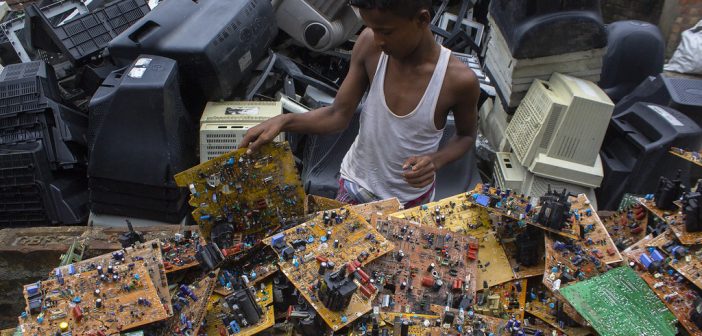India’s economic boom has been fueled by a surge in technology adoption. From smartphones and laptops to televisions and refrigerators, electronics have become an integral part of everyday life. However, this progress comes with a hidden cost – a rapidly growing mountain of electronic waste, or e-waste. This report delves into the alarming situation of e-waste in India, exploring its types, hazards, steps to take for better management, and potential solutions for prevention and reduction.
A Rising Tide of E-waste: Drowning in Discarded Devices
India is the world’s third-largest generator of e-waste, trailing only China and the United States. According to a 2023 report by the Associated Chambers of Commerce and Industry of India (ASSOCHAM), the country generated a staggering 1.6 million metric tonnes (MT) of e-waste in 2021-22. This figure is projected to reach a mind-blowing 5.2 million MT by 2025, highlighting the exponential growth of this environmental threat.
Unpacking the Problem: A Closer Look at E-waste Types
E-waste encompasses a diverse range of electronic equipment nearing the end of its useful life. Here’s a breakdown of the major categories:
- Large household appliances: Refrigerators, washing machines, televisions, air conditioners, and other bulky electronic devices fall under this category.
- Small household appliances: Toasters, microwaves, vacuum cleaners, and other smaller electronics contribute significantly to the e-waste stream.
- Information and communication technology (ICT) equipment: Personal computers, laptops, tablets, mobile phones, and their peripherals are a rapidly growing segment of e-waste.
- Consumer electronics: Television sets, set-top boxes, video game consoles, and other entertainment devices contribute to the growing problem.
- Medical devices: Outdated medical equipment, including X-ray machines, monitors, and other diagnostic tools, require proper disposal.
A Looming Threat: The Hazards of Improper E-waste Management
Improper e-waste disposal poses severe threats to human health and the environment. Here’s why it’s crucial to address this issue:
- Toxic Chemicals: E-waste contains hazardous materials like lead, mercury, cadmium, arsenic, and brominated flame retardants. When improperly disposed of, these toxins can leach into the soil and water, contaminating food chains and posing a risk to human health.
- Air Pollution: Informal recycling practices often involve burning e-waste to extract valuable metals. This releases toxic fumes laden with heavy metals and dioxins, polluting the air and causing respiratory problems.
- Water Pollution: Acidic leachate from improperly disposed of e-waste can contaminate water sources, poisoning aquatic life and making water unfit for human consumption.
- Soil Contamination: Landfills overflowing with e-waste contaminate the soil with heavy metals, impacting agricultural productivity and jeopardizing food security.
Taking Action: Strategies for a Sustainable Future
Combating the e-waste crisis in India requires a multi-pronged approach:
- Strengthening Legislation: Enhancing existing e-waste management regulations and enforcing stricter penalties for violations is crucial. The Extended Producer Responsibility (EPR) principle, which holds manufacturers responsible for the end-of-life management of their products, needs stronger implementation.
- Promoting Formal Recycling: Investing in and incentivizing formal e-waste recycling facilities equipped with proper technology to extract valuable materials and safely dispose of hazardous components is essential.
- Raising Public Awareness: Educating the public about the dangers of e-waste and promoting responsible disposal practices is vital. Campaigns can encourage consumers to choose eco-friendly devices, opt for repairs instead of replacements whenever possible, and utilize designated e-waste collection centers.
- Promoting Research and Innovation: Supporting research on cleaner recycling technologies, developing substitute materials for hazardous components, and promoting extended product lifespans through design improvements are crucial for long-term solutions.
- International Cooperation: Collaboration with developed nations to share best practices, transfer technology, and facilitate knowledge exchange can significantly enhance India’s e-waste management capabilities.
Preventing the Tide: Strategies for E-waste Reduction
Beyond managing existing e-waste, focusing on prevention is key:
- Promoting Circular Economy Principles: Encouraging the design, production, and consumption of electronics with longer lifespans, easier repair options, and the use of recyclable materials can significantly reduce e-waste generation.
- Right to Repair: Supporting consumer rights to access spare parts and repair manuals for electronic devices can extend their lifespan and deter unnecessary replacements.
-
- encourage manufacturers to design more sustainable products.
- Consumer Education: Empowering consumers to make informed choices by promoting eco-certification labels, encouraging responsible upgrades (focusing on features and functionality), and discouraging planned obsolescence tactics employed by some manufacturers.Green Procurement Policies: Government institutions and corporations prioritizing the purchase of energy-efficient and durable electronic equipment can set a positive example and
- Conclusion: A Collective Responsibility for a Greener Future
The e-waste crisis in India is a complex challenge, but it’s not insurmountable. By implementing a combination of stricter regulations, promoting formal recycling, raising public awareness, and focusing on prevention strategies, India can create a more sustainable future. Collaboration between government, industry, and consumers is essential to ensure responsible e-waste management and protect the environment for generations to come. Every step taken, from proper disposal practices to choosing durable electronics, contributes to a cleaner and healthier India.





